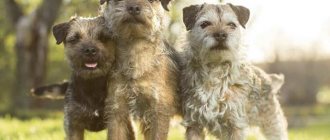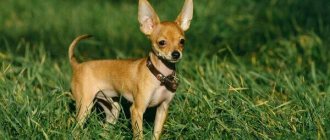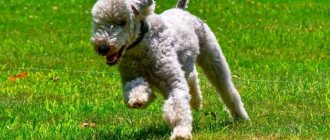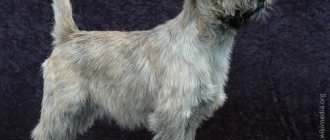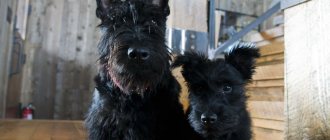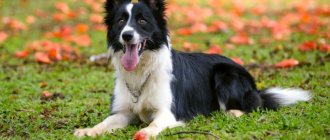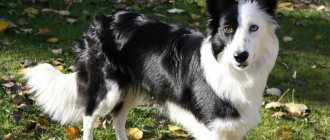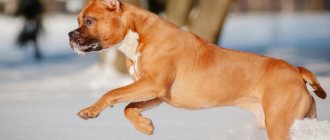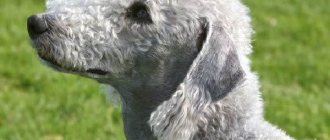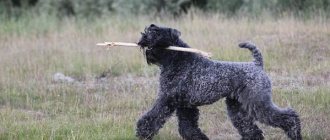Brief history of origin
Border Terriers were first mentioned in the 1872 book The Dogs of the British Isles. However, scientists believe that they appeared already in the 14th century. The animals hunted badgers, foxes and small burrowing game along with a pack of hounds. They were kept on farms, where they exterminated rodents, and were used as shepherds.
This is interesting. Border Terriers lived on the border of Scotland and England, which gave the breed its name. Translated from English, border means “border”.
In 1920, the breed received recognition from the English Kennel Club, and in 1930 from the American Kennel Club. At the same time, the British Border Terrier Club appeared. Now dogs of this breed remain excellent hunters. But more often they are found as companions and family friends.
Health and life expectancy
The dog is in good health and needs all necessary vaccinations according to age. Borders are sensitive to anesthesia, which can create difficulties during treatment. But their advantage is a low pain threshold.
There are some specific diseases:
- dysplasia (in old dogs);
- eye diseases;
- allergies (to food, pollen);
- epilepsy.
Life expectancy is on average 12-14 years.
Interesting Facts
Interesting facts about the breed:
- In Sweden, Border Terriers are used in search and rescue operations.
- Fans of the breed include representatives of the royal family in Holland.
- Border Terriers are among the twenty most numerous breeds of the English Kennel Club. Animals of this breed are popular in the USA, Finland, Denmark and Sweden.
- Representatives of the breed work with volunteers in hospitals, hospices, and nursing homes. After communicating with positive dogs, people feel better and their mood improves.
- Border Terriers have no fear of horses - they can safely walk between the hooves without thinking about their own safety.
- Some dogs of this breed can smile. They stretch their lips and show their teeth when they see something pleasant. For example, a beloved owner.
Advantages and disadvantages
Dogs of this breed are very attached to their owner. They are benevolent, get along well with other family members, are friendly to children, can spend all their time with them, take part in all children's games, but remain, however, always wary of strangers. In agility and other speed competitions, boarders are incomparable leaders.
The disadvantages of the breed include a highly developed hunting instinct, which does not allow keeping rodents and birds with the pet. Border walks are carried out only on a leash. You can only release your dog in special fenced areas intended for walking dogs, since any cat, bird or rodent will be instantly susceptible to being pursued by a born hunter.
Border Terriers make excellent companions
Borders are a breed for energetic owners who lead an active lifestyle and are willing to take long walks every day. Don't forget that Border Terriers are pack dogs and need to be taught to interact with other breeds.
Breed description, standards and appearance
The Border Terrier is a well-balanced dog with a strong and muscular body.
Ideal sizes:
- Male weight – 5.9-7.1 kg, female – 5.1-6.4 kg. However, the specified breed parameters are only a guideline. There are cases where dogs whose weight exceeded the upper limit won at exhibitions.
- Growth is not regulated by the standard. Although in documents of the 1930s figures of 30-40 cm were mentioned. Now the average measurements are 35-37 cm for boys, 32-35 cm for girls.
Description of the Border Terrier breed (ICF standard No. 10):
- The head is like the head of an otter. When assessing the exterior, experts pay special attention to it.
- The skull is flat and quite wide between the ears.
- The muzzle is short, but not so short as to cause bulging eyes.
- The nose is large with wide nostrils, necessary for excellent nose. Black pigmentation of the earlobe is encouraged, but Border Terriers with a brown or flesh-colored nose are not rejected.
- A scissor bite is desirable, but a pincer bite is also acceptable. Overshot and undershot are serious shortcomings.
- The eyes of the representatives of the breed are set quite wide, the iris is dark in color. The look is lively and insightful.
- The ears are small, V-shaped, of moderate thickness. They hang on the cartilage along the cheekbones, looking forward.
- The neck is of medium length. It develops into well-developed shoulders, which help the dog to move easily and freely.
- The body is stretched and narrow - thanks to it, the Border Terrier can follow wherever the fox penetrates. The lower back is strong.
- The chest is moderately deep. It has enough room for the heart and lungs, which allows the dog to run long and fast. The ribs are elastic and well sprung, but not too prominent.
- The tail is relatively short. Expands as it approaches the base. It rushes provocatively and high, but the border terrier should not throw it on its back.
- The limbs are straight and strong. Long enough for a dog to run tirelessly after a horse. The paws are compact with dense pads.
All dogs of this breed with physical or behavioral abnormalities are subject to disqualification.
Expert opinion
Leonid Rodin
Experienced dog breeder
Ask a Question
The Border Terrier can be called a dog that defies expectations. At first glance, the dog does not seem too active. But here there is a catch - when hunting, border terriers can chase game on a par with taller and longer-legged dogs. The character also has a double bottom. The dog loves people very much and is capable of not taking its eyes off its owner for hours. However, she tolerates loneliness well, without throwing tantrums with howling or barking. A fenced yard is best for keeping a Border Terrier. But if you place him in an apartment, the dog will not feel cramped at all. The main thing is to follow a walking regime, giving you the opportunity to run and jump to your heart’s content. According to all the listed criteria, such a pet can claim the title of the most problem-free dog. Only the appearance let us down. Border Terriers are most similar to ordinary mongrels running around the streets of cities in all countries and on all continents. Even here they continue to deceive, hiding under an unpresentable appearance a purebred breed that has a pedigree line of several centuries.
Color and coat type
The Border Terrier has a coarse and thick coat, which perfectly protects against bad weather and animal bites. The face has a characteristic beard and mustache.
Additional warmth is provided by a short, felt-like undercoat. Thanks to this coat, the dog can work outdoors for a long time.
The most common borders are red and wheaten colors, as well as the “grizzly” shabby color with red tan markings. Blue and tan dogs are less common. All legal suits are of equal value.
Small white spots on the chest are not welcome. The muzzle and ears may be a darker shade.
This is interesting. Puppies are born brown or black. The final color is formed by six months.
Price and where to buy
When buying a puppy, you need to choose a kennel. There are several of these: Miksmira, Greenferry and others. Price ranges from 10,000 to 50,000 rubles. When purchasing, you need to get to know the breeders, look at the living conditions of the dogs, the puppy’s parents (if possible), and check all the documents.
Pros and cons of the breed:
| Advantages | Flaws |
| Keeping possible in an apartment or country house in an insulated enclosure | The hunting instinct is highly developed, so it can run after a cat and get lost |
| Finds a common language with children | Digs holes near the fence, can jump over a small fence |
Thus, the Border Terrier is a rare hunting breed of dog. It has changed little over the period of development. This energetic baby will become a favorite of children and a good companion for hunters.
Character and behavior
Brave Border Terriers with even temperaments make excellent companions. Active and playful dogs love to be the center of attention, but never impose themselves. They always maintain self-esteem, show independence, and sometimes behave somewhat sternly.
Despite the external coldness, the breed needs to communicate with the owner. Dogs are ready to spend all the time with their owner - walking, playing or just lazing around.
Border Terriers need adequate physical and mental exercise. If the dog does not find an outlet for his irrepressible energy, he will turn into a hurricane and turn the whole house over.
On a note. Most Border Terriers love to ride in the car and practically do not suffer from seasickness, so you can safely take your pets with you on trips.
Representatives of the breed do not raise their voices over trifles and are wary of strangers, so they make good watchmen. If something happens, the vigilant dog will notify the owner with a loud bark. But due to its innate friendliness, the pet will not attack a person.
Borders do not conflict with other dogs, since they have worked together with their relatives for a long time. But due to their developed hunting instinct, they cannot be kept together with rats, hamsters and other rodents. The attitude towards cats depends on the character of the particular pet.
Animals usually get along if they grow up in the same territory from childhood. But an adult representative of the Border Terrier breed will not refuse to chase street cats.
Breed and children
The Border Terrier will be a good friend for children. However, you should not leave your pet alone with your child. These dogs do not tolerate disrespectful treatment - you cannot pull their ears and tail, climb into their mouths and squeeze them if they do not want it.
For your information. Your pet will be more interested in teenagers who can spend time with him playing active games.
Characteristics of the Border Terrier
The Border Terrier is an active, hardy and fearless dog. But at home she turns into a good-natured, affectionate and sociable pet. He is cheerful, playful, always ready to play pranks. This dog is very inquisitive, he is interested in everything. To explore the world around him, he can jump or climb anywhere, dig under a fence and run away.
This dog is not aggressive at all. She is friendly with all family members, becomes attached to them, and tries to be around them all the time. She is friendly with strangers, although she is always ready to fearlessly rush to her owner’s defense. Despite its small stature, this terrier is capable of protecting the territory - it notifies with a loud bark about any intruder.
Border Terriers get along well with children, but only of school age. They enjoy playing with the child, running and frolicking. They are patient, but will not tolerate serious disrespect or pulling of the fur or tail. They can harbor a grudge and even begin to take revenge, although they will never bite. Therefore, you should not leave your dog alone with small children.
The Border Terrier is friendly with other dogs and never gets into conflicts. But if necessary, he is ready to stand up for himself. At home he gets along well with cats, although he does not tolerate rodents - as he is a born rat-catcher.
Training
Border Terriers are very smart, quick-witted, and easy to train. They are able to learn many commands in a short time. If you find the right approach to the dog, it will obey unquestioningly and react even to the gestures and movements of the owner. The first two years are important for character development. An adult, well-mannered dog does not cause any problems.
Early socialization is necessary. The puppy must get used to other dogs, strangers, and street noise. It is advisable to take your pet to dog parks where he can run and play. He will be happy to accompany his owner on runs and bike rides.
At home, you immediately need to accustom the puppy to the place, name, and routine. It is important to load him with mental and physical exercises. Out of boredom, a dog can chew furniture, shoes, and damage upholstered furniture and wallpaper with its claws. It is advisable not to leave him alone for a long time, buy a lot of toys that he can chew. The main attention should be paid to the following commands:
- to me;
- stand;
- near;
- it is forbidden;
- ugh.
The Terrier requires adherence to the regime. Training should be regular and consistent. It is advisable to diversify them and combine them with games so that the dog does not get bored. These dogs are good at learning tricks and can participate in agility, frisbee and other types of dog sports. Borderers may become distracted during a lesson and even run away if something interests them. Rudeness and physical punishment are unacceptable, but you need to encourage and praise your pet more often.
Dogs begin to be trained for hunting at 6 months. Before this, she must immediately respond to the nickname and come on command. It is advisable that such classes be conducted by an experienced hunter or dog handler. If off-leash training is carried out in an unfenced area, the dog must have a chip or an address tag.
Interesting video on how to train these dogs:
Video: Border Terrier flash agility
Video: Border Terrier training.
Video: Search for partridge - border terrier sherry (shmulya)!
How to choose the right puppy?
Dog experts advise buying puppies only from nurseries or private breeders who have earned a good reputation. Dogs that have health problems or serious defects in appearance and temperament are often sold through advertisements on the Internet.
A responsible breeder will definitely take an interest in the future of his charges. Indifference and the desire to get rid of the litter as soon as possible should alert you. Perhaps the person is hiding something.
Normally, Border Terrier puppies do not show aggression and are not timid. They are keenly interested in everything that is happening and boldly go out to get acquainted.
In healthy puppies:
- shiny coat without wounds or ulcers;
- clean ears and eyes;
- cool and moist nose;
- moderately well-fed body.
It is advisable to ask the breeder to show the parents and their pedigrees. You should familiarize yourself with the results of tests for the presence of hereditary diseases.
Together with the puppy, the breeder must hand over a passport with notes on vaccinations and a metric, which is then changed to a pedigree. To be on the safe side, it is worth concluding a purchase and sale agreement. It guarantees the purebred of the puppy.
For your information. Border terriers are still not very common in Russia, so puppies are quite expensive: pet class - from 20 thousand rubles, breed class - from 30 thousand, show class - from 40 thousand.
Training
A special approach to training a Border Terrier is not required. The main thing is to avoid physical force, rudeness and coercion. By constantly punishing a puppy, you can only achieve that it will become offended, lose interest in activities and stop following commands. It is better to train a puppy in a playful way, constantly encouraging and praising. The breed is easy to train and intelligent. If you motivate a dog correctly, it will be very obedient. Activities should be varied, otherwise the pet will start to get bored. There are several basic commands; every dog must be taught them:
- Place. Each dog must know its place and go there on command. To train your pet, you need to lay down a bedding and say a command in a stern voice.
- Ugh. A command is needed when a dog tries to chew something, rush at a person, or acts like a hooligan or gets in the way.
- Sit. The command begins to be taught when the puppy is two months old.
- Lie. They begin to teach it when the puppy knows the command to sit.
The pet always tries to please the owner. The Border Terrier will especially enjoy activities that require quick reactions, competition, pursuit and hunting. He will also enjoy exercises to overcome obstacles.
Caring for puppies
The puppies are breastfed for the first month of life. Breast milk contains the optimal amount of nutrients necessary for proper development.
If a female has problems with lactation, special formulas for feeding puppies are purchased at the pet store. Baby food is not suitable - its composition does not meet the needs of the dog's body.
When the puppies are one month old, they begin to be fed:
- milk;
- egg yolk;
- finely chopped meat;
- pureed vegetables.
At 2-2.5 months, a Border Terrier puppy is usually handed over to a new owner. You should arrange a cozy bed in advance, allocate a place for feeding, and buy the necessary accessories and toys.
In the new home, the puppy continues to be fed the usual foods to avoid allergies. The list of allowed food is clarified in advance with the breeder.
As the Border Terrier grows older, the following is introduced into the diet:
- cottage cheese;
- kefir;
- milk and meat porridges.
Give unfamiliar food carefully, starting with 1 teaspoon. If there are no digestive problems, it is left on the menu.
At 3 months, Border Terrier puppies begin to be fed sea fish. It is added to porridge instead of meat 1-2 times a week. It is useful to add seaweed to your puppy’s food - it is a source of iodine.
With the beginning of teeth change, the proportion of fermented milk products, which are a source of calcium, is increased. Calcined supplements are selected together with the veterinarian. From time to time, the puppy is given large beef bones to chew on.
At 4 months, by-products are introduced into the dog’s diet, but their amount should not exceed 10-15% of the total volume of meat products. It is advisable to exclude milk and replace it with fermented milk products.
At six months, a Border Terrier puppy eats almost the same as an adult dog. However, he needs to eat a little more as he is actively developing. The daily amount of food for a puppy is determined at the rate of 7-8% of its weight.
The number of meals depends on age. Up to 2 months, puppies are fed up to 7 times a day. As you get older, the frequency of feedings is reduced and portions are increased:
- 2-4 months – 5 times;
- 4-6 months – 4 times;
- 6-10 months – 3 times.
From the age of 10 months, a Border Terrier puppy is fed twice a day - morning and evening. If desired, the dog can be switched to dry food.
Mating
The first mating is carried out no earlier than 1.5 years (for males 1 year), although it is advisable to wait until 2-2.5, which is when the dog reaches full maturity. To select a match for your pet, the owner needs to contact the kennel club or directly to the owner of a suitable candidate.
Parents are selected taking into account that the advantages of one compensate for the disadvantages of the other, and all the positive characteristics are only enhanced in the future offspring.
Both members of the pair must have sufficient show scores for breeding that confirm their suitability for the future goal. Parents must have age-appropriate vaccinations and be treated for helminths. At the first meeting, the female is brought to the male’s territory, mating is repeated 1-2 more times with an interval of about a day.
Read a detailed article on the topic: “Everything you need to know about breeding dogs: appropriate age, what to do if it doesn’t work out, rules and tips.”
Care and maintenance of an adult dog
The best place for a Border Terrier to live is a private house with a spacious yard. The dog cannot be outside all the time because it urgently needs contact with people. But your own plot will allow the restless dog to frolic to his heart's content.
When living in an apartment, the owner will have to devote more time to walks and outdoor games.
Important. The area should be well fenced. The Border Terrier can dig under and run away.
The right diet
Border terriers are prone to food allergies, so you need to approach diet planning with special responsibility.
Dogs can be given hypoallergenic dry food of premium and superpremium classes or holistic level, designed for active breeds.
Protein should predominate in the composition - high-carbohydrate foods are not suitable for Border Terriers.
With a natural diet, the basis of the diet is lean meat and high-quality offal (liver, lung, heart, tripe). Once a week the dogs are fed sea fish.
Also included in the daily menu of Border Terriers:
- oatmeal, rice, buckwheat porridge;
- fermented milk products – kefir, fermented baked milk, cottage cheese, yogurt;
- vegetables - zucchini, pumpkin, carrots, cucumbers.
In the summer, it is useful to add fresh herbs to food - parsley, dill, lettuce, young nettle and dandelion. Twice a week a chicken egg is mixed into the porridge. Many dogs enjoy eating fruits - apples, pears, bananas, peaches. They are given in small quantities as treats.
Important. Owners should limit portion sizes as Border Terriers become overweight quickly.
Food from the human table is prohibited, any salty, spicy, spicy, pickled and smoked food. You should avoid potatoes, legumes, freshwater fish, tubular bones and sweets.
Walking and physical activity
Border Terriers are walked 2-3 times a day. The total duration of walks should be at least 2 hours. The dog needs to run free, so it is better to take it to deserted parks or squares.
However, your pet should not be let off the leash if it does not always follow the command “Come to me!”
The dog will accompany the owner while he rides a bicycle, roller skates or skis. It is advisable to periodically visit training grounds with various obstacles to develop dexterity and coordination.
On a note. Border Terriers achieve great success in agility, coursing and Frisbee.
Training and education
Border Terriers are highly intelligent, and their desire to please their owner makes training much easier.
The training of a puppy begins immediately after it arrives in the house. The baby is introduced to all family members, after which he is taught:
- to your own name;
- sleep on a bed;
- maintain a regime of activity and rest;
- relieve yourself on the street.
Important. Border Terriers love to chew things. That's why kids buy a lot of toys of different colors and sizes.
From 3 months, the puppy is actively socialized - taken to crowded places, shown to other people and animals. If the Border Terrier is timid, calm him down with a gentle tone.
From 4 months they begin training in a playful way. Lessons are done no longer than 15 minutes, otherwise the puppy will get tired and refuse to obey. During the learning process they smoothly move from simple to complex.
It is important that the puppy understands exactly what is required of him. Otherwise, he will fuss around, trying to please the owner, or simply leave to avoid punishment for disobedience.
In adolescence, attempts to dominate are possible, which should be immediately stopped. The Border Terrier must learn that the owner is the undisputed leader. If your puppy is showing disobedience, you can:
- sternly reprimand;
- deprive you of your favorite toys;
- leave alone for a while.
Screaming and physical violence are prohibited.
Hunting dogs begin to be trained at six months. It is better to do this under the guidance of an experienced hunter and in the company of trained animals. To prevent the Border Terrier from getting lost in nature, it is advisable to provide the puppy with a dog tag with the owner’s address and a chip.
Care and hygiene
Border Terriers do not require any special care. It is enough to comb the fur once a week with metal and massage brushes. Like other wire-haired breeds, the dog will need trimming every six months.
Grooming these animals with scissors is contraindicated as it disrupts the natural structure of the coat. It is recommended to only pluck the hairs inside the ear so that they do not interfere with air circulation.
Important. To prepare your Border Terrier for a show, you should contact a professional groomer. He will process the animal's fur, highlighting its best features.
Border Terriers are bathed extremely rarely. Their coat is covered with a protective film that repels water and dirt. If there is slush outside, wipe the pet with a damp cloth after a walk.
Otherwise, Border Terriers require standard care:
- Ears are examined once a week. Discharge is removed with a cotton swab soaked in hydrogen peroxide or boric acid.
- Be sure to wipe your eyes after going outdoors, and at other times - as needed.
- Nails are trimmed 1-2 times a month if the dog does not grind them down on his own.
- Once a week, brush your teeth using a special brush and veterinary paste. To prevent tartar, the Border Terrier is given brain bones or dental treats to chew on.
- Once every 3 months, dogs are wormed; in the warm season, they are regularly treated for blood-sucking parasites.
At least once a year, the pet is taken to the veterinarian for a preventive examination.
Tips for choosing a puppy
Attention should be paid not only to the appearance of the puppy, but also to its behavior. A healthy baby will run and play. Having noticed a visitor, he will run up and start sniffing you. If the baby does not play with his brothers and sisters, but sits alone, know that training or treating such a dog will cost you your own nerves.
Find out as much as you can about not only the Border Terrier puppy's parents, but also about their previous litters. Contact people who bought puppies before you and ask about their health and behavior. They usually don't vary much from litter to litter. If you feel that you cannot figure it out on your own, invite a knowledgeable person with you who will ask all the necessary questions.
You can separate a puppy from its mother no earlier than two months, or even later. At this age, babies are already quite independent and quite active. Vaccinations for this age have already been done, and the quarantine has passed after them. In addition, the character of the future pet is already making itself felt, which will give you the opportunity to independently choose the dog with which you will spend the next few years of your life.
Please pay attention to the conditions in which dogs are kept. If they are kept in a cage, it must be clean. If in an enclosure, there must be hay or bedding where dogs can sleep or just lie around. They should always have access to their mother and a bowl of clean water. Puppies should be clean and smell good. There should be no dirt or debris of solid food in the mouth or under the tail.
You should not take a puppy from a breeder if:
- you are not allowed into the dogs' enclosure;
- they are not allowed to meet the parents of the litter;
- the owner cannot provide you with evidence of the parents’ merits;
- the enclosure is dirty and smells of dog waste products;
- The owner breeds dogs of a different breed.
All this can lead to the purchase of an unhealthy or non-purebred baby. It’s better not to risk it and visit another nursery.
Vaccinations and susceptibility to disease
Border Terriers are vaccinated according to the standard schedule. At 2-2.5 months, puppies are given a comprehensive vaccine against the most dangerous diseases. After 21 days, revaccination is carried out to strengthen immunity.
The rabies vaccination is given at the same time or postponed until the end of the teeth change. Adult dogs are vaccinated every year.
For your information. The vaccination schedule can be changed by your veterinarian.
Border Terriers rarely get sick, but they are prone to certain pathologies:
- dysplasia of the hip or elbow joint;
- Perthes disease (congenital anomaly of the musculoskeletal system);
- epilepsy;
- ataxia (cerebellar dysfunction);
- ophthalmological diseases;
- cryptorchidism.
With quality care, Border Terriers can live up to 15 years.
For your information. These dogs have a high pain threshold, which makes timely diagnosis of diseases and detection of injuries difficult.
Possible diseases
The breed is a long-lived dog, they live up to 20 years. In addition, they are known for high immunity and low disease rates. Some diseases, however, can appear in a pet.
The most common:
- dysplasia of the hip joints of the hind legs (mostly hereditary);
- eye cataract;
- epilepsy;
- obesity due to poor nutrition;
- allergic reaction to any food;
- Puppy ataxia (death of newborn puppies within a few days after their birth, caused by infectious diseases).
The level of genetic diseases, compared to other breeds, is very low.
Pros and cons of the breed
| pros | Minuses |
| Loyalty and friendliness | Requires long walks |
| Small sizes | Does not tolerate rodents |
| Developed intelligence | Tendency to allergies and obesity |
| Loves children | |
| Does not conflict with other dogs |
The Border Terrier is a breed for an energetic person who is ready to take long walks. Having spent time on his upbringing and care, the owner will receive an unusually devoted and sociable friend.
Breed traits
Breed traits (on a 5-point scale)
| Border Terrier | |||
| Activity | in the house | 4 | |
| on the street | 4 | ||
| Obedience | training | 3 | |
| strangers | 3.3 | ||
| Domination | in family | 2 | |
| over dogs | 2.2 | ||
| Defending your territory | from people | 2 | |
| from dogs | 2.8 | ||
| Sociability | in family | 5 | |
| with strangers | 4 | ||
| with dogs | 3 | ||
| Concentration | in family | 1 | |
| in front of strangers | 1.6 | ||
| with dogs | 2 | ||
| Aggressiveness | in family | 1 | |
| to strangers | 2 | ||
| to the dogs | 2 | ||
| to cats | 2 | ||
| Family behavior | calmness | 4 | |
| demand for affection | 4.7 | ||
| excitability | 4 | ||
| playfulness | 4.3 | ||
| excessive barking | 2 | ||
| behavioral breakdowns | 2 | ||
| Tolerance for children | up to 4 years | 3.5 | |
| over 4 years old | 4 | ||
| Institutional use | watchman | 3.4 | |
| bodyguard | 1.6 | ||
This breed is often compared to the following dog breeds: Bedlington Terrier, Australian Terrier, Beagle, Affenpinscher, Miniature Schnauzer (Dwarf Schnauzer).
The photo shows what a border terrier looks like:
